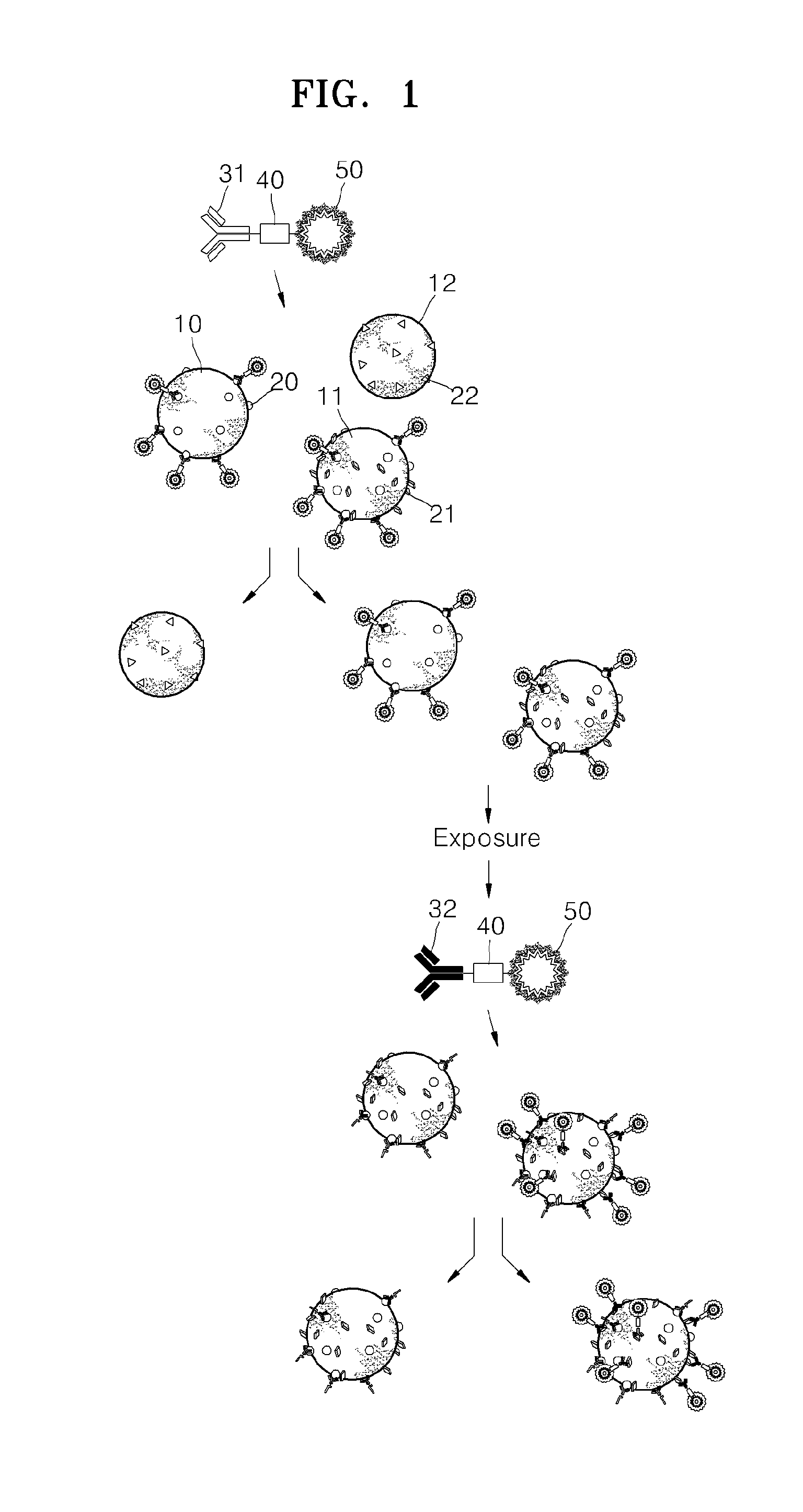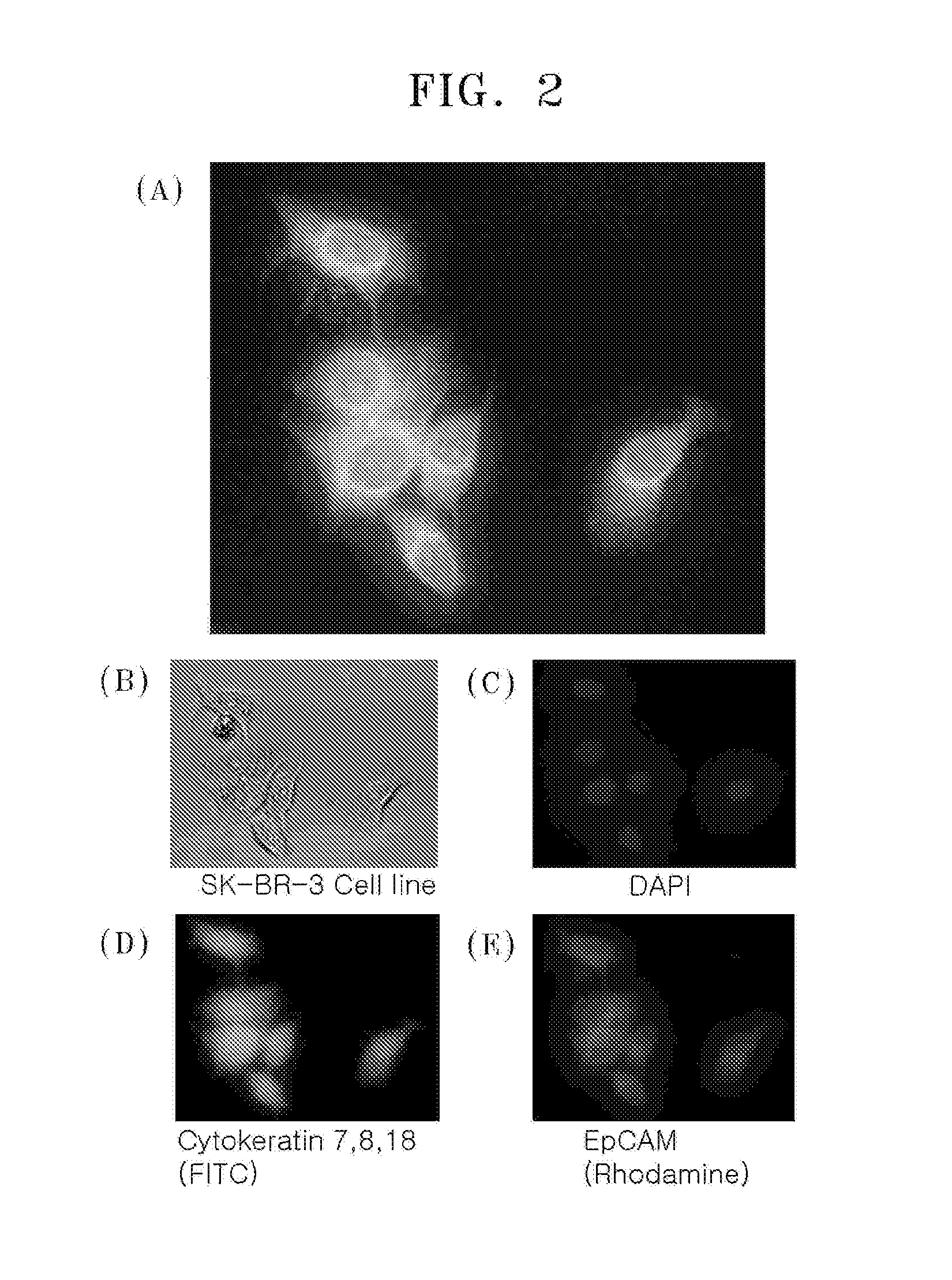Method of isolating or counting target cells by using photocleavable linker coupled with fluorescent dye
a technology of fluorescent dye and target cells, which is applied in the field of isolating or counting target cells by using photocleavable linkers coupled with fluorescent dyes, can solve the problems of inability to precisely isolate blood cells in repeated isolation processes, and inability to easily selectively isolate blood cells
- Summary
- Abstract
- Description
- Claims
- Application Information
AI Technical Summary
Benefits of technology
Problems solved by technology
Method used
Image
Examples
example 1
Cancer Cell Labeling by using Antibody-Photocleavable (PC) Linker-Fluorescent Dye Complex
[0039]10 μL of 50 nmol heterobifunctional photocleavable linker (self-manufactured, see formula below) in DMF and 15 μL of 50 nmol dye solution (Fluorescein PEG Thiol (MW 5000), Rhodamine PEG Thiol (MW 5000), Nanocs Inc.) in 50 mM phosphate buffer (pH 5) were reacted for 30 minutes at room temperature.
[0040]100 μL of 10 nmol anti-cytokeratin 7, 8, 18 antibody or anti-EpCAM antibody in 1×PBS was added, and the mixture was reacted overnight at 4° C. Then, unreacted dye was removed by using an Amicon® Ultra centrifugal filter (Millipore, MW 30,000), and the resulting product was concentrated five-fold. 5 μL of the obtained antibody-PC linker-dye complex was added to a PBS buffer solution with 1% BSA, and breast cancer cells SK-BR3 were added into the mixture and stirred at a rate of 15 rpm for 1 hour. Binding between SK-BR3 and the complex was confirmed by a fluorescent microscope (Olympus IX81).
[0...
example 2
Verification of Dye Dissection According to Light Exposure
[0042]Breast cancer cells BT474 were fixed with 4% paraformaldehyde for 10 minutes, and treated with 0.2% Trition-X 100 for 10 minutes to increase permeability of the cells. After adding 1% BSA solution, the cells were stained with an anti-cytokeratin antibody-PC linker-FITC complex or an anti-IGFR antibody-PC linker-Rhodamine complex for 60 minutes at room temperature. Then, the cells were washed with 1×PBS and observed under a fluorescent microscope while increasing an intensity of irradiation (J) of light at a wavelength of 365 nm.
[0043]FIG. 3 shows a fluorescent signal change of FITC and Rhodamine dye bound to the breast cancer cells BT474 according to light exposure. It was confirmed that as the intensity of irradiation increased, an intensity of the fluorescent signal decreased, and accordingly a ratio of dye being removed increased.
example 3
Staining Reset Cells
[0044]Breast cancer cells SK-BR3 were fixed with 4% paraformaldehyde for 10 minutes, and treated with 0.2% Trition-X 100 for 10 minutes to increase permeability of the cells. After adding 1% BSA solution, the cells were stained with an anti-cytokeratin antibody-PC linker-FITC complex or an anti-IGFR antibody-PC linker-Rhodamine complex, respectively, for 60 minutes at room temperature. Then, the cells were washed with 1×PBS, exposed to light (20 J) at 365 nm, followed by staining the cells with the anti-EpCAM antibody-PC linker-FITC complex or the anti-EGFR antibody-PC linker-Rhodamine complex, respectively, for 60 minutes at room temperature, and measuring fluorescence intensity of the cells according to each dye complex. Cells of a control group were treated in the same manner as described above in regard to fixing the cells, increasing permeability of the cells, and BSA blocking, followed by staining the cells with an anti-EpCAM antibody-PC linker-FITC complex...
PUM
| Property | Measurement | Unit |
|---|---|---|
| temperatures | aaaaa | aaaaa |
| temperatures | aaaaa | aaaaa |
| temperatures | aaaaa | aaaaa |
Abstract
Description
Claims
Application Information
 Login to View More
Login to View More - R&D
- Intellectual Property
- Life Sciences
- Materials
- Tech Scout
- Unparalleled Data Quality
- Higher Quality Content
- 60% Fewer Hallucinations
Browse by: Latest US Patents, China's latest patents, Technical Efficacy Thesaurus, Application Domain, Technology Topic, Popular Technical Reports.
© 2025 PatSnap. All rights reserved.Legal|Privacy policy|Modern Slavery Act Transparency Statement|Sitemap|About US| Contact US: help@patsnap.com



